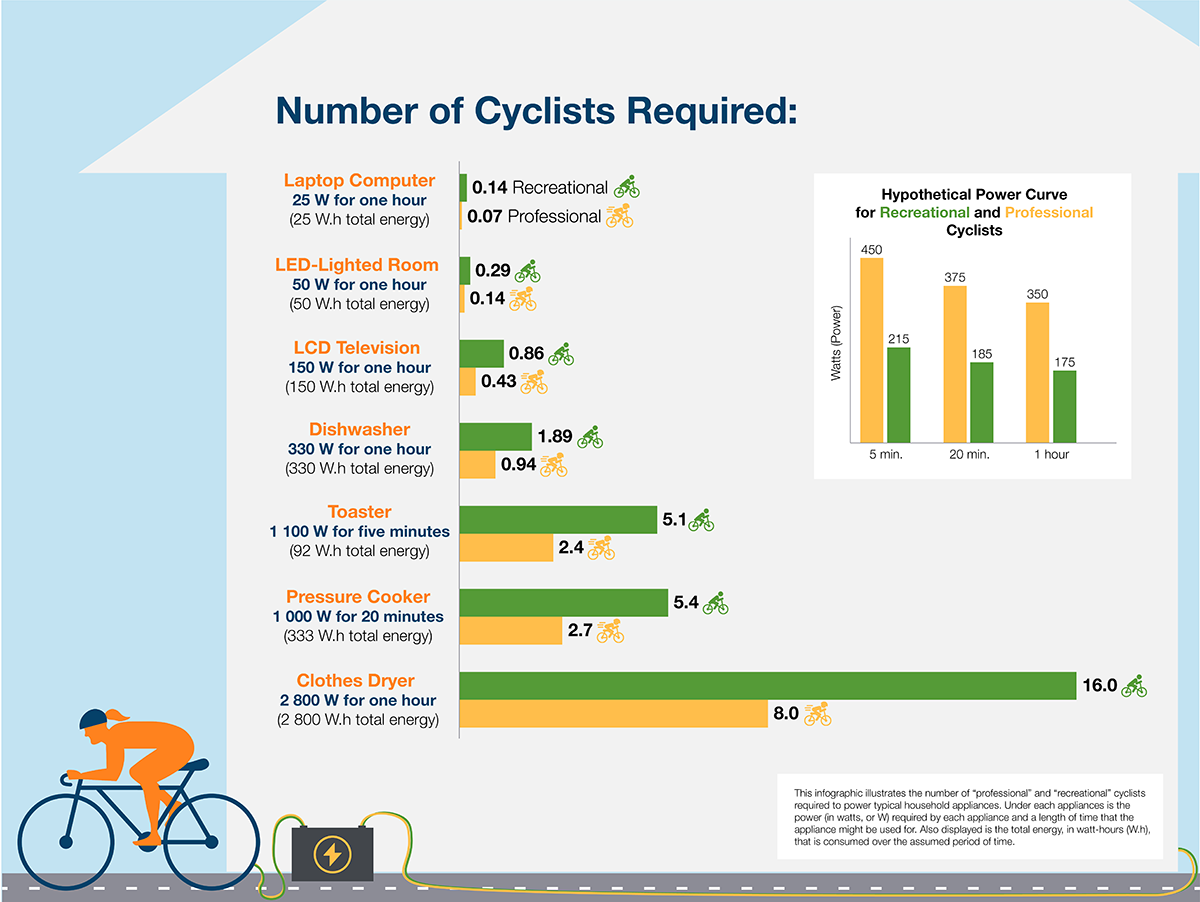Market Snapshot: Is it possible to power your home with a bicycle?
Connect/Contact Us
Please send comments, questions, or suggestions for Market Snapshot topics to snapshots@cer-rec.gc.ca
Release date: 2021-06-02
World Bicycle Day, an annual celebration of the uniqueness and versatility of the bicycle, falls on June 3. For nearly two centuries, the bicycle, or two-wheeled ancestorsFootnote 1 of the modern bicycle, have served as a means of transportation, recreation, and sport for billions. This versatile machine has led us to an unexpected question: can a bicycle power a home?
The power of a cyclist can be measured in watts (W). Assuming an average “recreational cyclist” is capable of pedaling for an hour with a steady power output of 175 W, the total work performed (or energy expended) is 175 watt-hours (W.h). This recreational cyclist would be capable of generating higher output over a shorter period, or lower output over a longer period. By comparison, a “professional tour cyclist” may be capable of sustaining 350 W (or more) over an hour. During a five-second sprint, a professional cyclist is capable of producing power above 1 500 W.Footnote 2
Similarly, the power draw of a household appliance can be measured in watts. The power draw of appliances can differ substantially. An LCD television draws 150 W of power, meaning watching television for an hour would result in a total energy use of 150 W.h. A typical toaster draws 1 100 W of power, however, typically over a considerably shorter period. The total energy consumed by a toaster over a five minute period would be 55 W.h. While this is less than the 150 W.h consumed watching television for an hour, the power required during those five minutes is over seven times greater.
Figure 1 illustrates the number of recreational and professional cyclists required to power common household appliances.Footnote 3
Figure 1. The (Im)practicality of Powering Your Home with a Bicycle

Source and Description
Source: CER, Energy.gov, hypothetical power curve loosely-based on data from Cycling Analytics
Description: This infographic illustrates the number of recreational and professional cyclists required to power several household appliances.
- A 25 W laptop computer turned on for an hour requires 0.14 recreational cyclists or 0.07 professional cyclists.
- A room with 50 W of LED lights turned on for an hour requires 0.29 recreational cyclists or 0.14 professional cyclists.
- A 150 W LCD television turned on for an hour requires 0.86 recreational cyclists or 0.43 professional cyclists.
- A 330 W dishwasher operating for an hour requires 1.9 recreational cyclists or 0.94 professional cyclists.
- A 1 100 W toaster operating for five minutes requires 5.1 recreational cyclists or 2.4 professional cyclists.
- A 1 000 W pressure cooker operating for 20 minutes requires 5.4 recreational cyclists or 2.7 professional cyclists.
- A 2 800 W clothes dryer operating for one hour requires 16.0 recreational cyclists or 8.0 professional cyclists.
This analysis concludes that, with the exception of a few low power-draw appliances, a bicycle is a highly impractical (if not impossible) and sweaty way of powering a typical Canadian home.Footnote 4 Other comparable analysis has arrived at similar conclusions.Footnote 5
Fortunately, the bicycle remains an incredibly practical means of transportation, with one of the highest energy efficiencies, lowest emissions, and lowest personal and social costs as a mode of transportation. The United Nations noted in May 2020 that the bicycle, and active transport in general, serves as a critical but overlooked part of the mobility solution for a post-COVID-19 “green recovery.”
In Canada, temporary bike lanes were installed in 2020 in many cities in response to the sudden boom in active transportation and outdoor recreation because of COVID-19 restrictions, while bike shops found themselves unable to keep up with demand. The second annual report of the Pan-Canadian Framework on Clean Growth and Climate Change second annual report highlights the importance of low and non-emitting transportation for Canada’s transition to a low-carbon economy, and notes that cycling as a method of commuting has increased 61.6% between 1996 and 2016.
- Date modified:
